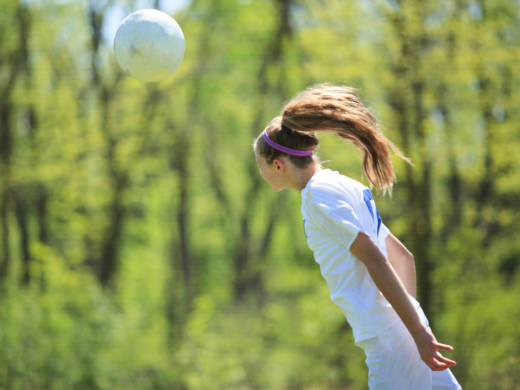An important note about this research, Lipton says, is that it isn't about concussions. Instead, it's measuring "sub-concussive injuries," or repeated impacts that don't cause any immediate, acknowledged problem for the player, but could be problematic in the long-term.
"It's actually more important to define what's happening in people that are not yet symptomatic, because that's where there's still an opportunity to head off long-term problems," he says.
It's already known that female soccer players are at a higher risk of concussion than males. Wellington Hsu, a professor of orthopedic surgery at Northwestern University, led a decade-long study of injuries among high school athletes that found this.
But the current study gives additional evidence that women are more susceptible to the impact of heading, and shows more areas of women's brains are susceptible to potential injury than men's.
Hsu, who was not involved in the current study, says while it's not possible to draw firm conclusions from the study alone, it suggests a path forward for making the sport safer.
"What I think this paper may lead to is further research in the preventative mechanisms of concussions, whether or not it's a brace or a helmet or heading technique or a different way we think about this in men and women," Hsu says.
Women are more likely to report concussion-related symptoms than men, but Lipton says there has been debate over whether women actually are more sensitive or just more likely to speak up.
This study confirms that there are changes in the tissue of women's brains after these repetitive hits from the soccer ball that are different from men in a similar situation.
"This is the first time anybody has put a definitive piece of information behind what has been a contentious dispute as to whether women's brains are intrinsically more sensitive, or whether it's an artifact of reporting of symptoms," Lipton says.
It's unclear why women more biologically likely to be affected by repetitive heading. Lipton says it could have to do with sex hormones, or with the fact that women typically having less body and muscle mass than their male counterparts.
Thomas Kaminski, a professor of kinesiology and applied physiology at the University of Delaware, who was not involved in the study, says that the differences in these changes in the brain could have to do with neck strength. Women typically have weaker necks and smaller heads than men.
Does this research mean women should hang up their cleats forever? Probably not, says Lipton. There are a lot of brain health benefits to getting active, and women are actually okay to head the ball up to a certain point.
"We're not saying that you head the ball and then you're brain injured," Lipton says. "The data consistently shows that there seems to be some level of exposure to these repeated impacts which is pretty well tolerated by most people. It's really a matter of figuring out how much is too much."
Lipton says he hopes to find out if there's a safe threshold on heading impact for women. The latest FIFA data shows 265 million people play soccer across the globe, and Lipton says, adverse effects when multiplied by that many people "potentially [pose] a huge public health concern."
"The problem isn't that [soccer is] creating all kinds of vegetative, brain damaged people," he says. "But what's the potential benefit of athletics that's being given up by the effect of this kind of repeated head injury? And is there a way to strike a balance so that people can benefit maximally and not incur the adverse effects?"
Kaminski says it would be interesting to take this research one step forward and explore this problem in youth. In the U.S., youth players can start heading the ball at age 11. He thinks it's worth questioning whether that age cutoff should be older. Parents are faced with the issue of wanting their kids to be active but safe at the same time, he says.
"What happens if [children] head the ball ten times, or a hundred times?" he says. "Would you see these changes? Those are the big question marks I have."
Carla Garcia, a Brooklyn resident and participant in the study, has been playing soccer since she was five. Now 52, she says these results probably won't change the way she plays, but if she were younger, she would consider heading the ball a bit less. She joined the study as a way to give back to the sport she loves — and she even wants to donate her brain to science to help researchers understand brain injuries.
"I think it probably over the long term will have an effect on the way that younger women and younger people play, and I got involved for that reason," she says. "I thought that Dr. Lipton and his colleagues could find the way to make it safer for kids to play."

9(MDAxOTAwOTE4MDEyMTkxMDAzNjczZDljZA004))